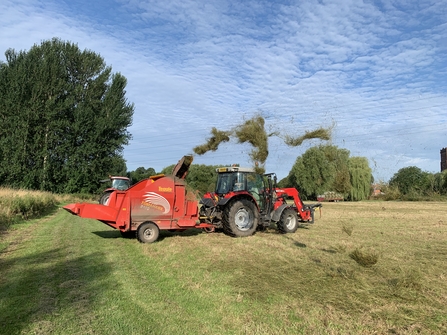The Council recognises the importance of nature and the urgent need to reverse its long term decline and we will be striving towards implementing the commitments we have made to support nature’s recovery across East StaffordshireEast Staffordshire Borough Council
|
On Monday 7 March members voted unanimously to pass a Motion for Nature’s Recovery, which was proposed by Council Leader Councillor Duncan Goodfellow and seconded by Councillor Bernard Peters. As part of the Nature Recovery Declaration, the council has committed to working with partners and stakeholders to develop and deliver a Local Nature Recovery Strategy (LNRS) that sits within the national Nature Recovery Network and underpins planning, development and land management decisions. As part of this the council will:
|

Green hay spreading at Burton washlands, summer 2021 - by Victoria Bunter
Green hay spreading at Burton washlands, encouraging a variety of meadow species to flourish and improving the habitat for insects.
|
Liz Peck, Advocacy and Campaigns Manager for the Trust, said: “The UK is one of the most nature-depleted countries in the world. Since the 1970s, we’ve seen declines in 41 per cent of our species, with 15 per cent threatened with extinction*. If we don’t take urgent action, we will lose much-loved wildlife such as hedgehogs for good. “ESBC’s pledge to support nature’s recovery is a vital step towards ensuring nature is given the focus and resources it needs. This Declaration for Nature’s Recovery demonstrates that the council recognises the nature crisis and is making a commitment to embed the restoration of the natural world within policy, on a par with the action it is taking to tackle the climate emergency.” Councillor Bernard Peters, Deputy Leader for Community Support and Regulatory Services, said: “I am pleased as Cabinet Member with responsibility for environmental health and climate change East Staffordshire Borough Council unanimously agreed to pass a motion on a Nature Recovery Declaration. The Council recognises the importance of nature and the urgent need to reverse its long term decline and we will be striving towards implementing the commitments we have made to support nature’s recovery across East Staffordshire.” Last month, following advice and support from Staffordshire Wildlife Trust, Staffordshire County Council voted unanimously to approve a Declaration for Nature’s Recovery. Staffordshire Wildlife Trust is calling on other local authorities to follow suit and commit to nature’s recovery, embedding the natural world into the heart of local decision-making. The solution to the nature crisis is complex and multifaceted but an important aspect is the careful and strategic management of land. To reverse nature’s decline, the landscape needs to be much more joined-up for nature. Nature needs more space dedicated to ecological recovery, with improved connectivity between these areas, so wild populations can expand and move around the landscape freely. The Wildlife Trusts call this vision a ‘Nature Recovery Network’. Read more about Nature Recovery Networks here. |
|
|
